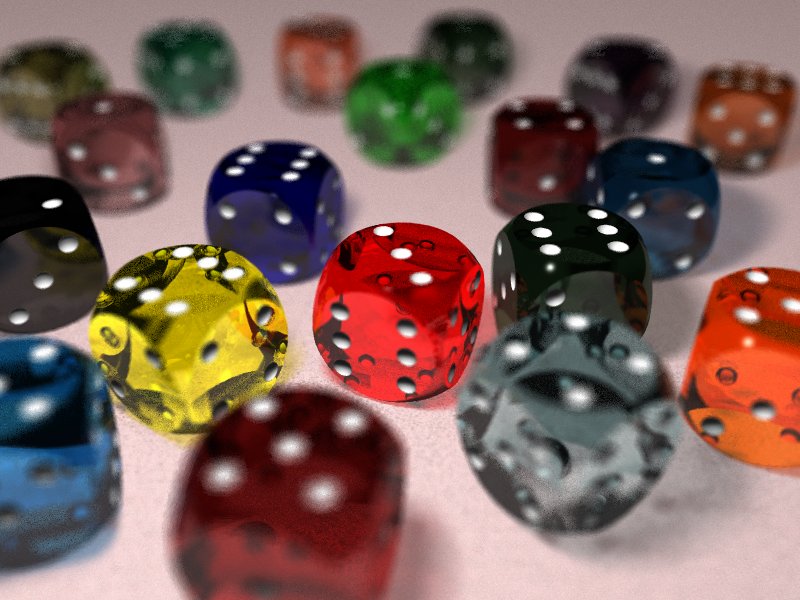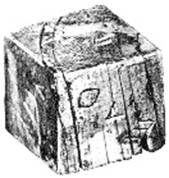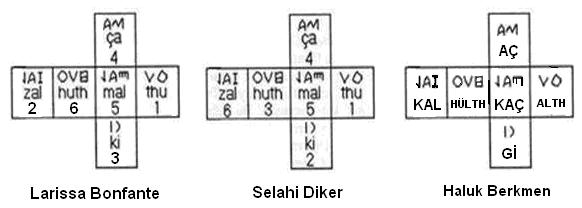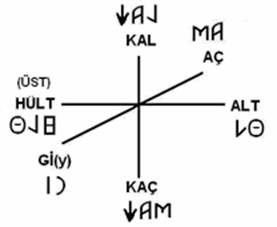اولین تاس جهان ساخته ترکان اتروسک
The Turk Etruscan Dice
تاس ترکان اتروسک
اولین تاس جهان

Doç. Dr. Haluk BERKMEN
The origin of the Etruscan population is still unclear and is being
constantly investigated by scholars on cultural, linguistic and genetic
grounds. Several major authors of the Roman Empire, such as Livy,
Cicero and Horace called them as Tusci or Tursci (1). These names are in
good agreement with Tur-Osc, discussed in the previous chapter. There
are several indicators pointing to the Asiatic origin of the Etruscan
population. Their language is known to be non-Indo-European and many
similarities have been found with both the Altaic –especially with
Turkish- as well as the Uralic languages (2).
Recently a
serious genetic research has been published by a group of Italian
scientists. They have investigated several bone samples from the
Etruscan remains and came up with the following conclusions (3):

Etruscan sites appear to have rather homogeneous genetic
characteristics. Their mitochondrial haplotypes are very similar, but
rarely identical, to those commonly observed in contemporary Italy and
suggest that the links between the Etruscans and eastern Mediterranean
region were in part associated with genetic, and not only cultural,
exchanges. The Etruscans show closer relationships both to North
Africans and to Turks than any contemporary population. In particular,
the Turkish component in their gene pool appears three times as large as
in the other populations.
Since the Turkish population
originated –to a large extent- from Central Asia, it can be claimed that
the Etruscans too came to Italy from Asia, through the Alp Mountains in
the north of Italy. Their early settlements were on a high plateau
named Valcamonica, where they left many marks in the form of petroglyphs
(see Chapter 6 and 7). A further sign for their Uighur origin is the
name of the Alp Mountains. Alp means “tall and formidable” in Turkish.
There are several proper names starting with Alp; such as Alpaslan,
Alpagut, Alperen, Alper and Alp-Er-Tunga.
There are also some interesting Etruscan artifacts which have been the focus of interest and have created a lot of controversy among scholars (4). One of them is the Etruscan dice (left) found in Tuscany. There are no numbers on the dice but short inscriptions in Etruscan letters. Scholars have tried to decipher these inscriptions and came up with different names for the numbers from 1 to 6. J. Friedrich says (4).

The inscriptions on the dice -being without any doubt numbers from one
to six- gave rise to a large literature on this issue. But the order of
these numbers is still unclear.
Below we see three different
interpretations of the Etruscan dice. The one at the left is the
interpretation of L. Bonfante (5). The central one is the interpretation
of Selahi Diker (6) and the one on the right is my interpretation.
I
did not interpret the letters as words standing for numbers, but
instead words standing for actions to be performed. This is because
carving letters is much more tedious and difficult than carving numbers,
logically. One would not choose to carve the name of a number in place
of the number itself. The assumption that these words stand for numbers
is a modern preconception based on modern dices.
The first
observation which I made was to identify the word “Gi” written from
right to left. This monosyllabic word is the ancient form of “Giy”,
which means “dress up” in Turkish. The second two-letter word is read
from right to left as “Ça” by L. Bonfante and S. Diker. I read it from
left to right as “Aç” meaning “open” or “undress”. There are Etruscan
inscriptions which have been written in both directions. Such a system
of writing is called boustrophedon, meaning “as the ox ploughs”. In this
system the hand of the writer goes back and forth like an ox drawing a
plow across a field and turning at the end of each row to return in the
opposite direction.
Once these commends have been deciphered
the remaining monosyllabic words could be easily identified as “Kal”,
Kaç”, “Hült” and “Alt”. These words are all words used still in modern
Turkish, with the exception of Hült. Kal means “stay”, Kaç means “run
away, escape” and Alt means “under, below”. Since we find opposite
meanings on opposite faces of the dice, it is obvious that Hült stands
for “over, above”, which is “Üst” in modern Turkish.

The H was probably aspirated and disappeared in modern Turkish. We can
see on the left how the six words are inscribed on the dice. Since these
words are certain commands to be performed, it is quite possible that
they had to be performed during a wrestling contest. My guess is that at
the start or during the contest the dice was cast by one wrestler and
he had to perform the command appearing at the top side of the dice.
These are: Kal: “stay erect”, Kaç: “run away”, Alt: “stay below”, Hült
“stay above”, Aç: “undress” and Gi: “dress”.
The Etruscan wrestlers could also wrestle totally undressed as the Etruscan wall painting below shows (7).
References
(1) Dictionnaire Illustré Latin Français, Félix Gaffiot, Librairie Hachette, 1934.
(2) Les Étrusques Étaient-ils des Turcs?, Adile Ayda, Paris, 1971.
(3) The Etruscans: A Population-Genetic Study, Am. Journal of Genetic Studies, March, 2004.
(4) Extinct Languages, Johannes Friedrich, Barnes & Noble, USA, 1993.
(5) Etruscan, Larissa Bonfante, University of California Press , 1990.
(6) The Whole Earth Was Of One Language, Selahi Diker, page 209, Izmir, 1996
(7) Ref. 1 of Chapter 4, Page 45.